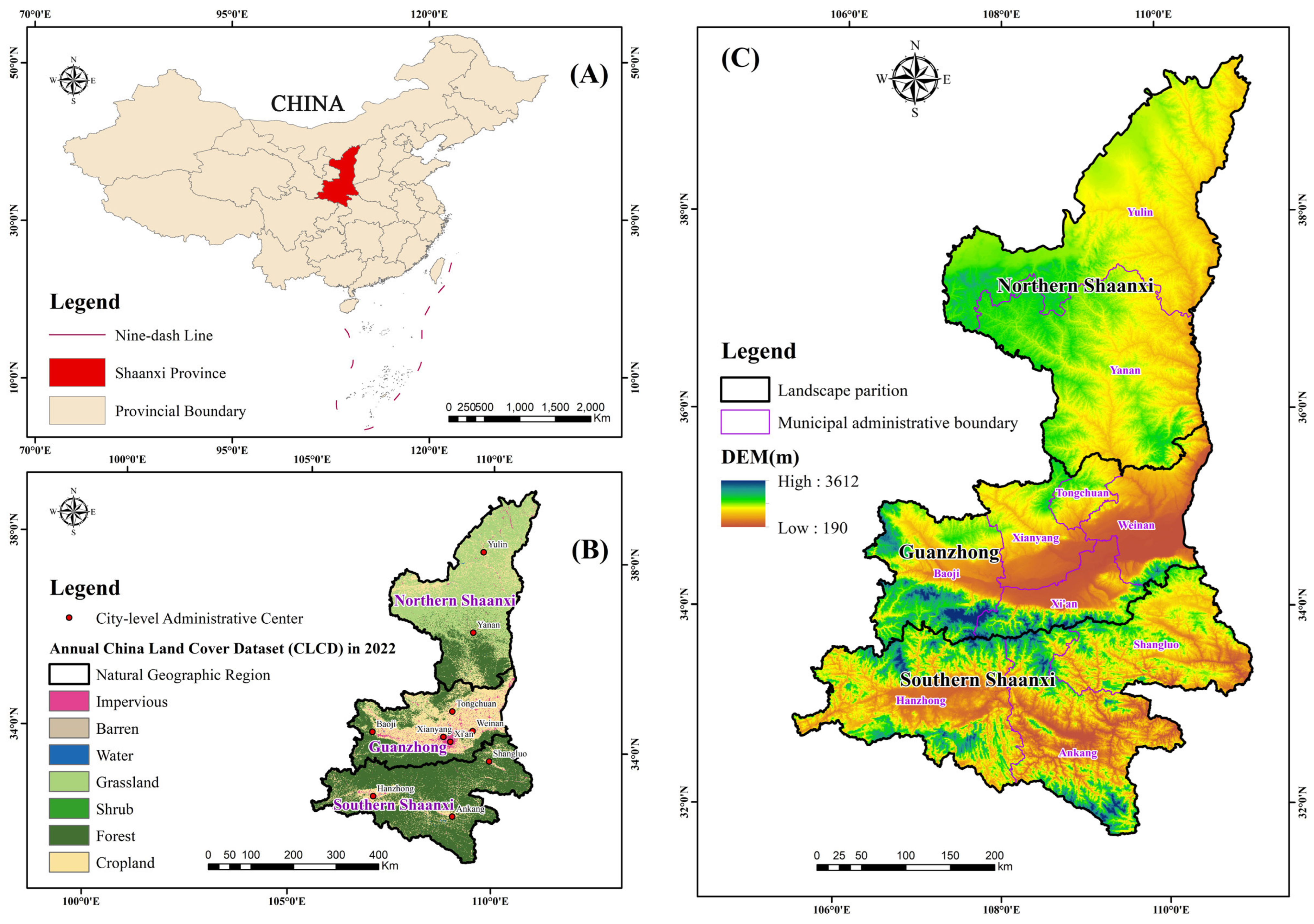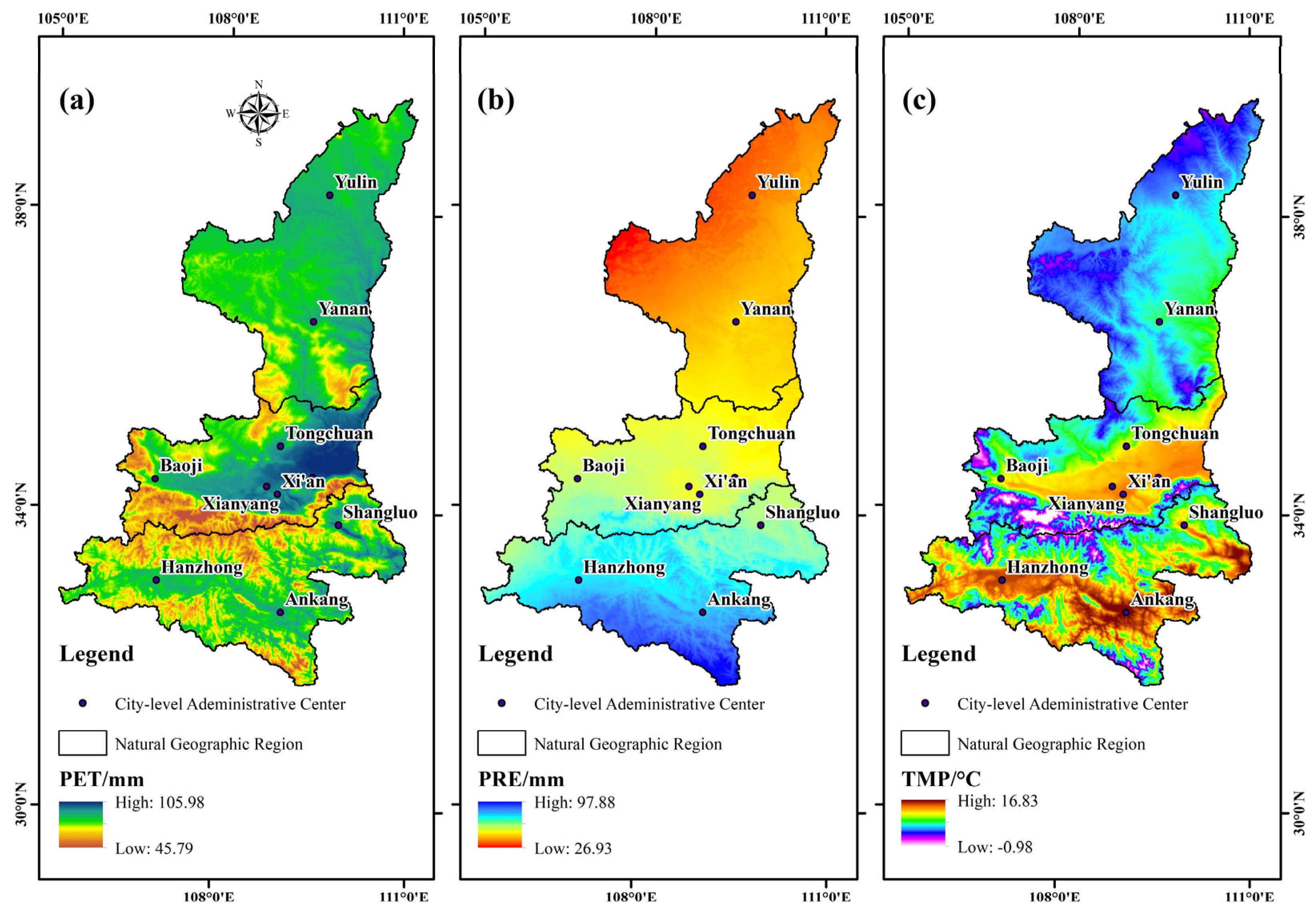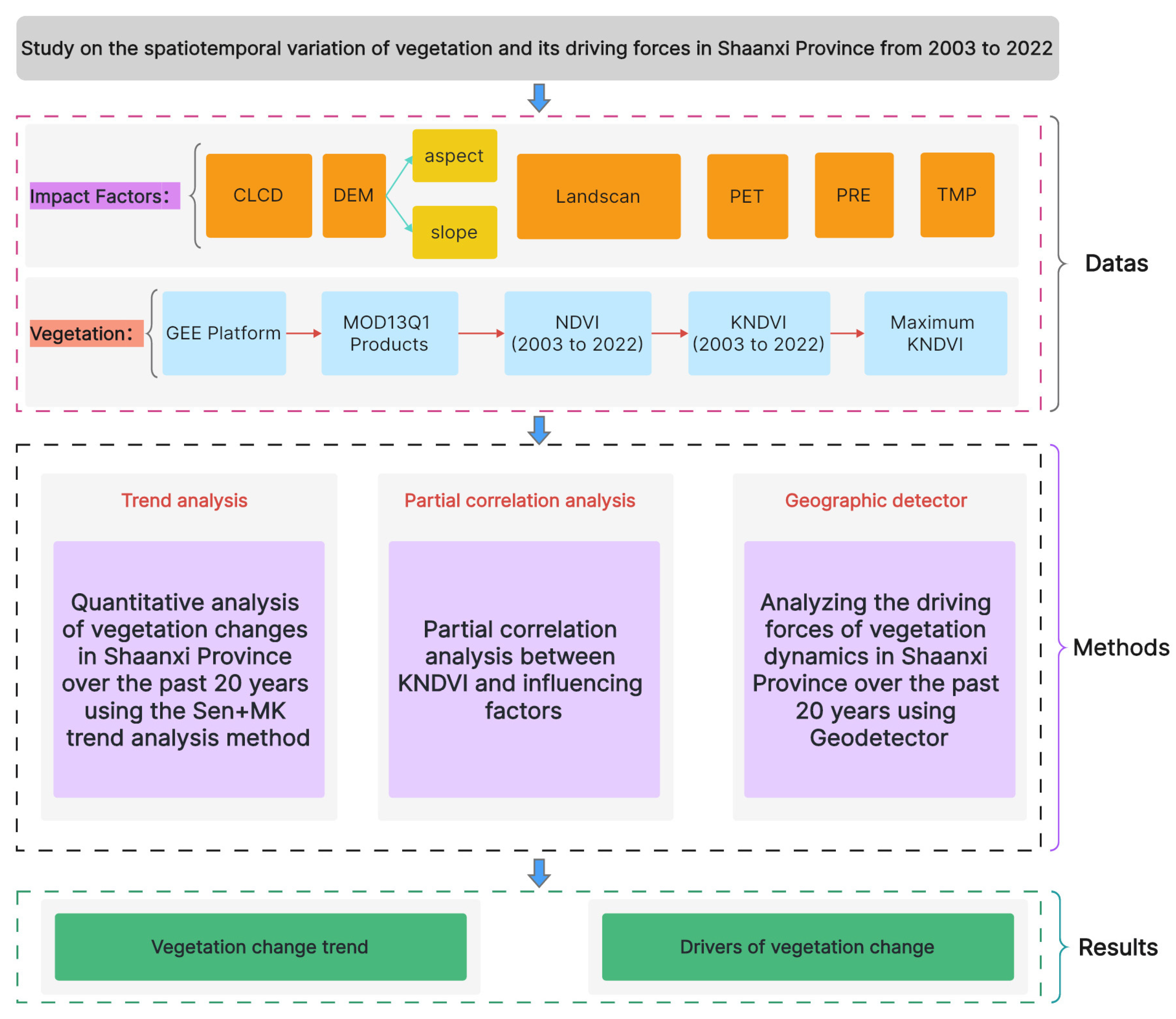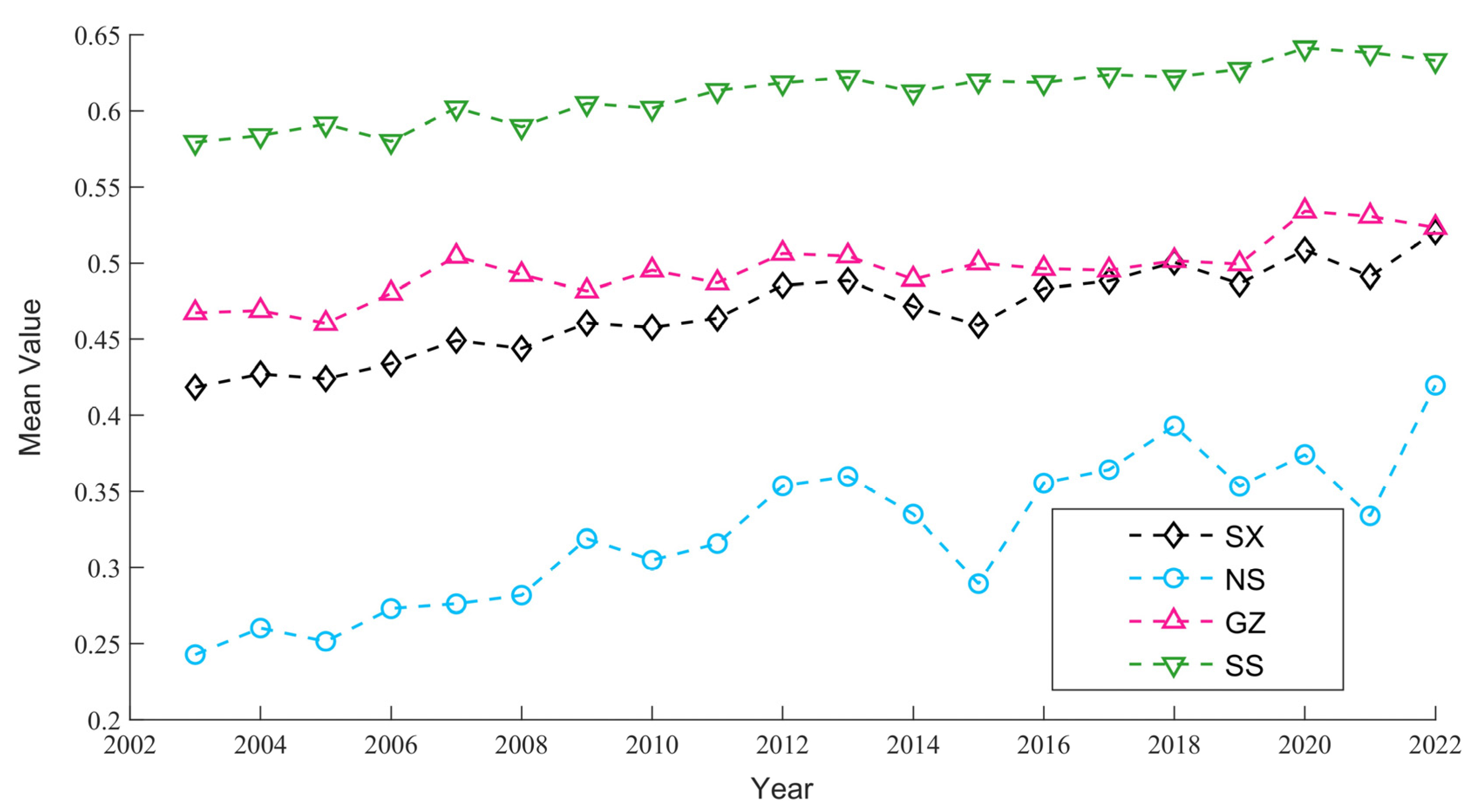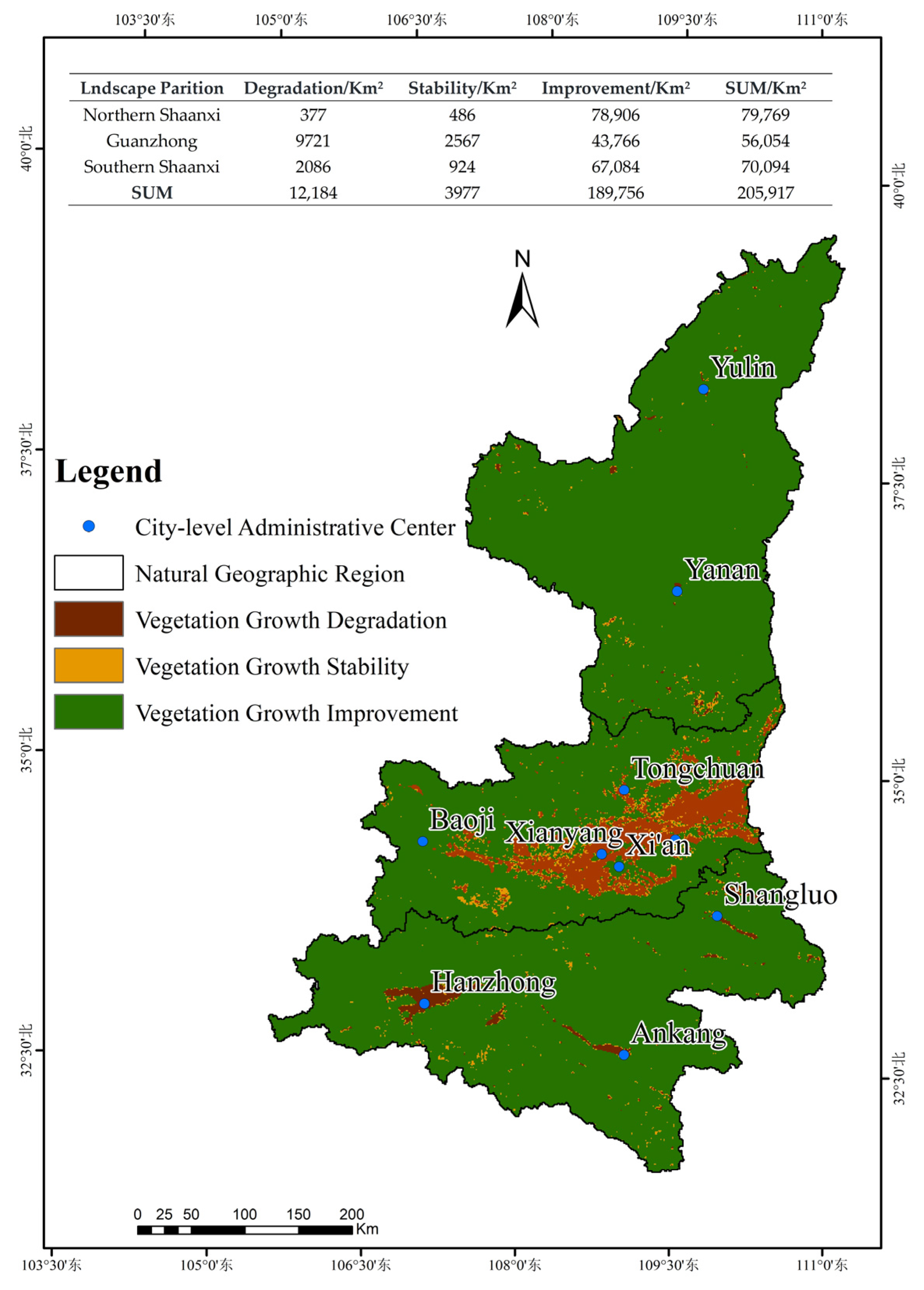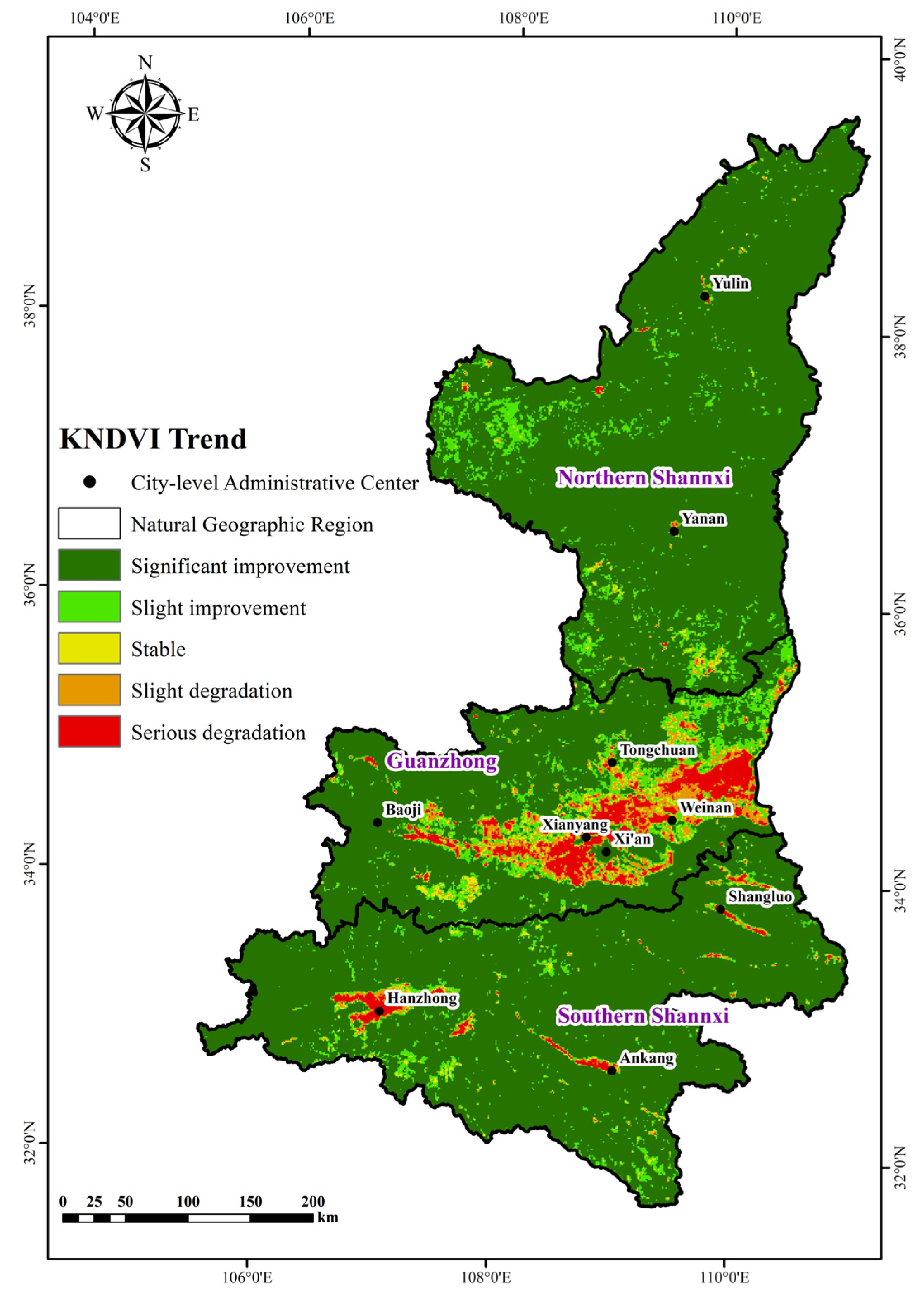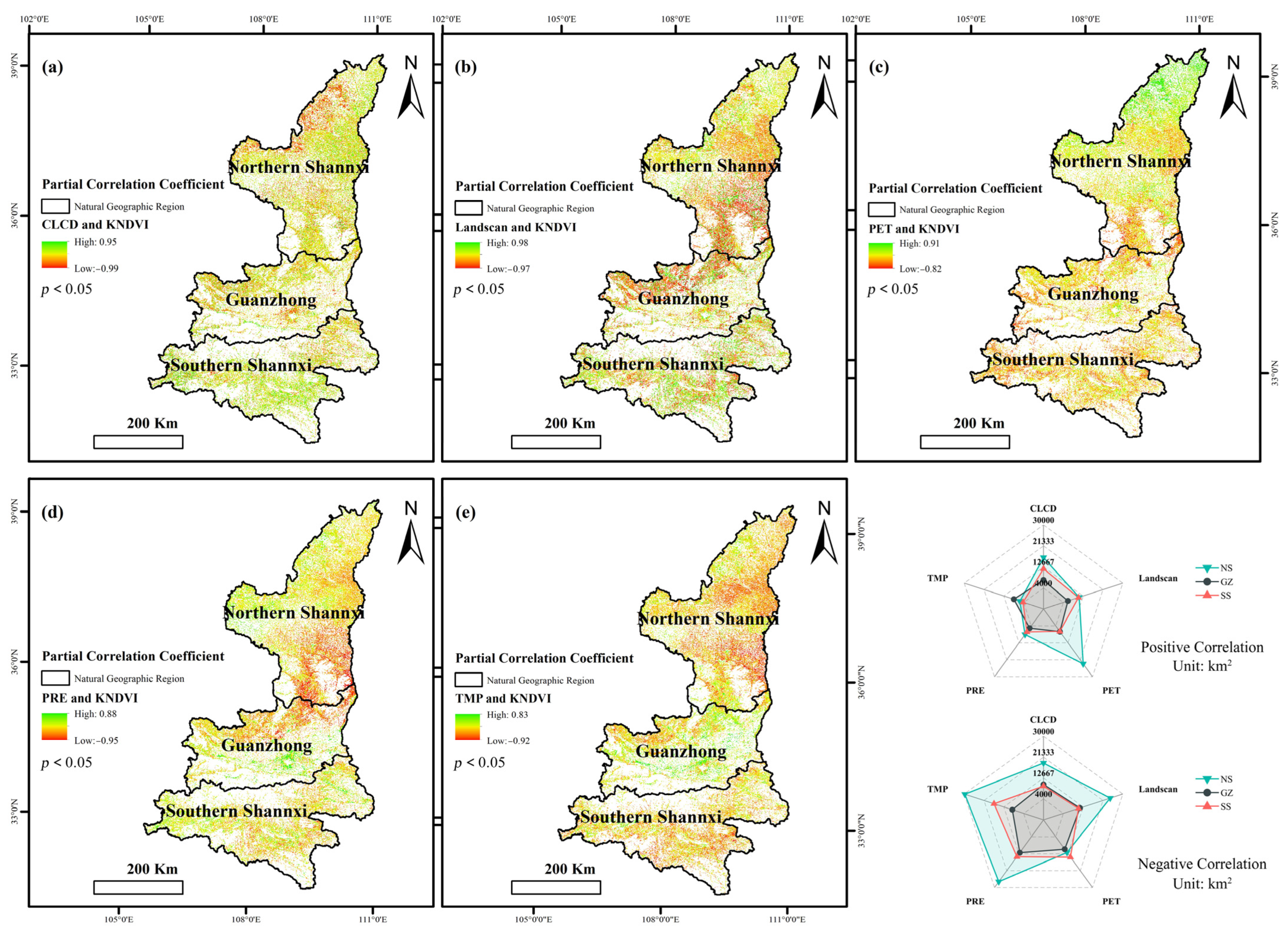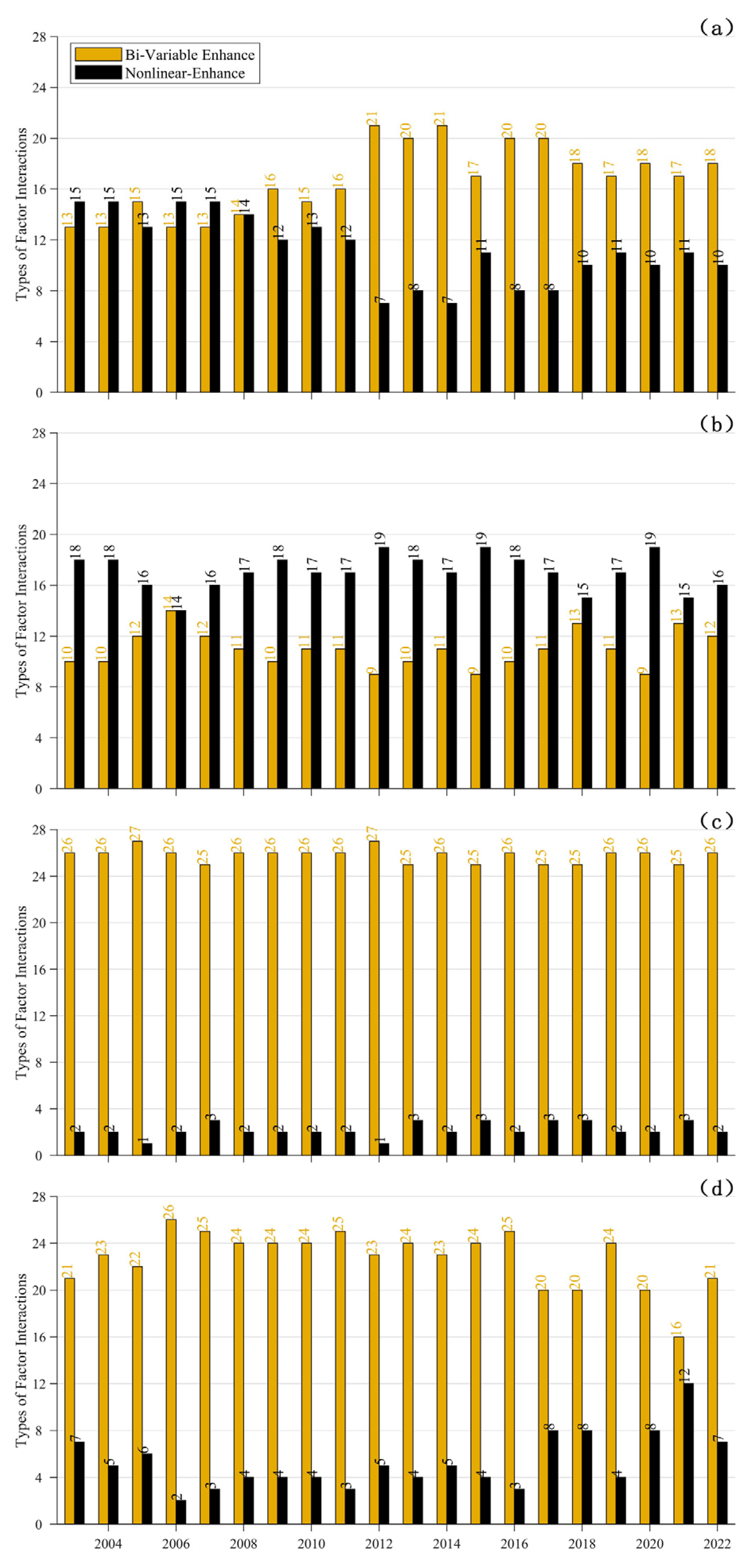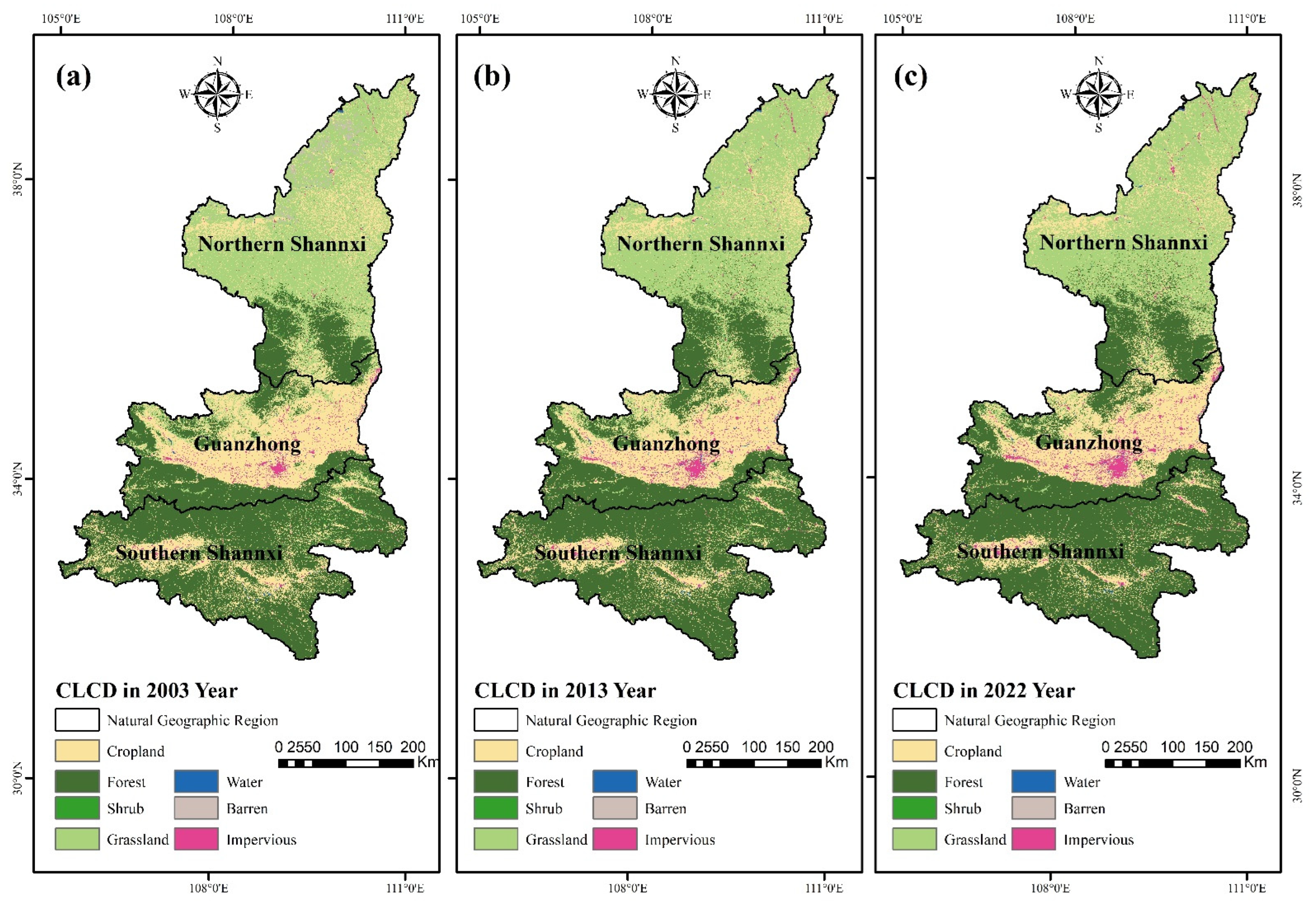5.1. Response of KNDVI to Influencing Factors
In this study, the relationship between the eight influencing factors—land-use type (CLCD), elevation (DEM), slope (Slope), aspect (Aspect), population density (Landscan/PD), annual average potential evapotranspiration (PET), annual average precipitation (PRE), and annual average temperature (TMP) and the changes in the KNDVI in Shaanxi Province from 2003 to 2022 was examined using the Geographic Detector.
Figure 9 displays the findings of the Geographic Detector’s single-factor study. Among them, (a), (b), (c), and (d) represent the single-factor detection results for Shaanxi Province, northern Shaanxi, Guanzhong, and southern Shaanxi, respectively. From
Figure 9a, it can be seen that there are significant differences in the contribution values (
q values) of each factor to the KNDVI of vegetation in the entire province of Shaanxi. By calculating the average
q values for each factor over the years and sorting them, the ranking is as follows: CLCD (0.655) > PRE (0.584) > PET (0.423) > Slope (0.382) > TMP (0.133) > DEM (0.093) > Landscan (0.023) > Aspect (0.007).
The changes in land-use type have caused significant variations in vegetation KNDVI, which may be related to anthropogenic factors such as urban expansion, afforestation, and reforestation. Precipitation is the most important climate factor affecting vegetation KNDVI changes, as adequate rainfall can promote vegetation growth. When analyzing the effects of different factors on vegetation KNDVI changes, we found that the year 2015 (q = 0.678) had the greatest impact of land-use type changes on vegetation k-NDVI values, 2003 (q = 0.117) for surface elevation, 2017 (q = 0.406) for slope, 2022 (q = 0.01) for aspect, 2022 (q = 0.085) for population, 2005 (q = 0.53) for annual potential evapotranspiration, 2004 (q = 0.789) for annual average precipitation, and 2007 (q = 0.176) for annual average temperature.
Different climatic conditions, natural environments, and vegetation types in different geographical regions result in varying effects of different influencing factors on vegetation KNDVI changes. For the northern Shaanxi region, the relationship of the effects of different influencing factors on regional vegetation KNDVI changes is as follows: CLCD (0.538) > PRE (0.524) > PET (0.386) > Slope (0.1) > TMP (0.098) > DEM (0.03) > Aspect (0.006) > Landscan (0.001). The year 2003 (q = 0.669) was found to have the greatest influence of land-use type changes on vegetation k-NDVI values, 2016 (q = 0.04) for surface elevation, 2012 (q = 0.118) for slope, 2022 (q = 0.008) for aspect, 2022 (q = 0.002) for population, 2003 (q = 0.587) for annual potential evapotranspiration, 2021 (q = 0.829) for annual average precipitation, and 2012 (q = 0.182) for annual average temperature. Thus, it can be seen that land-use type and precipitation are the most important influencing factors causing vegetation k-NDVI changes in the northern Shaanxi region.
For the Guanzhong region, the relationship of different influencing factors on regional vegetation KNDVI changes is as follows: CLCD (0.621) > DEM (0.587) > PET (0.496) > TMP (0.429) > Slope (0.342) > PRE (0.277) > Aspect (0.041) > Landscan (0.01). In the year 2022, land-use type, surface elevation, and slope were found to have the greatest influence on vegetation KNDVI changes, with the respective q values of 0.676, 0.658, and 0.408. The year 2019 (q = 0.051) had the greatest influence of aspect on vegetation KNDVI changes, 2007 (q = 0.016) for population, 2003 (q = 0.557) for annual potential evapotranspiration, 2005 (q = 0.351) for annual average precipitation, and 2012 (q = 0.495) for annual average temperature. Thus, it can be seen that land-use type, elevation, and evapotranspiration are the most important influencing factors causing vegetation KNDVI changes in the Guanzhong region.
For the southern Shaanxi region, the relationship of different influencing factors on regional vegetation KNDVI changes is as follows: DEM (0.43) > CLCD (0.378) > PET, PRE (0.217) > Slope (0.215) > TMP (0.068) > Landscan (0.041) > Aspect (0.021). The year 2020 (q = 0.452) was found to have the greatest influence of land-use type changes on vegetation KNDVI values, 2006 (q = 0.502) for surface elevation, 2022 (q = 0.262) for slope, 2014 (q = 0.025) for aspect, 2020 (q = 0.071) for population, 2003 (q = 0.338) for annual potential evapotranspiration, and 2011 (q = 0.123) for annual average temperature. Thus, it can be seen that elevation, land-use type, evapotranspiration, and precipitation are important influencing factors causing vegetation KNDVI changes in the southern Shaanxi region.
5.2. Examination of the Factors Influencing Vegetation KNDVI
The dynamic and multifaceted process of vegetation change is impacted by a wide range of variables. China has been implementing ecological measures since 2000, such as preserving natural forests and converting farms back to forests and grasslands. These actions have increased the amount of plant cover and promoted beneficial ecological growth [
67,
68,
69]. According to this study, there is a general tendency toward improvement as the KNDVI values of the vegetation in Shaanxi Province steadily rise from north to south. Shaanxi’s northern region, which makes up 98.92% of the territory’s total land, has seen the greatest increase in vegetation. The southern region, which makes up 95.71% of the region’s total area, is next in line. Lastly, 78.08% of its land is made up of the Guanzhong region. The northern Shaanxi region has shown the greatest improvement in vegetation, which is in line with earlier research [
70,
71,
72]. The primary factors impacting the development of vegetation are slope, evapotranspiration, precipitation, and land use. Shaanxi Province’s environment has become warmer and more humid over time, which might be good for the growth and recovery of vegetation [
73,
74,
75,
76].
From 2003 to 2022, the areas in Shaanxi Province with higher KNDVI values are mainly located in high-altitude regions such as the Qinling Mountains. These areas have suitable temperatures, sufficient rainfall, low human activity intensity, predominantly forest vegetation types, strong resistance to natural disasters such as soil erosion, and good vegetation stability, exhibiting low fluctuation. Therefore, these areas exhibit high KNDVI values. The areas with lower vegetation KNDVI values are primarily located in urban areas with intensive human activities, such as the Guanzhong urban agglomeration, including cities such as Xi’an, Xianyang, and Baoji, or in environmentally harsh desertification areas, such as regions near the Mu Us Desert in northern Shaanxi.
This work maps the findings of the interactions among numerous factors in Shaanxi Province, as shown in
Figure S1 (see
Supplementary Materials), in order to analyze the interactions between different factors in different years. With less noticeable interactions with elevation, slope, aspect, and population density, the figure shows a substantial association between land-use categories, yearly average precipitation, annual average evaporation, and annual average temperature. To elaborate, the association with other parameters like DEM, Slope, Aspect, and PD is less prominent, even if the correlation with CLCD, PRE, PRE, and TMP is strong. The strongest interacting factors for different years are summarized in
Table 3.
Table 3 shows that TMP ∩ PET and PRE ∩ PET are the main interaction variables influencing the vegetation KNDVI variations in Shaanxi Province. Over the 20-year period, there were 6 years of interaction between annual precipitation and annual potential evapotranspiration, and 9 years of interaction between annual average temperature and annual potential evapotranspiration. The statement makes it abundantly evident that the research area’s plant KNDVI fluctuations are mostly caused by the local climate.
The climate conditions vary in different regions of Shaanxi Province, with significant differences in vegetation types. This results in noticeable variations in the influencing factors among different natural geographical zones. Therefore, an analysis of the influencing factors and driving forces of vegetation KNDVI changes in different geographical zones is conducted.
Figure S2 (see
Supplementary Materials) illustrates the interactions of influencing factors in different geographical zones from 2003 to 2022.
The land-use type (CLCD), elevation (DEM), annual average precipitation (PRE), annual average evapotranspiration (PRE), and annual average temperature (TMP) show rather substantial interactions with other affecting elements, as shown in
Figure S2 (see
Supplementary Materials). Conversely, the relationships between population density (PD), aspect (Aspect), and slope (Slope) are less strong.
Table 4 provides a summary of the most influential elements for each year.
For the northern part of Shaanxi, the primary interacting factors affecting vegetation KNDVI changes are TMP ∩ PET and PRE ∩ PET. Over the 20-year period, there were 6 years of interaction between annual precipitation and annual potential evapotranspiration and 6 years of interaction between annual average temperature and annual potential evapotranspiration. This suggests that climatic conditions are the most significant driving force for vegetation KNDVI changes in the northern region.
The primary interacting elements affecting vegetation KNDVI changes in the Guanzhong area are DEM ∩ CLCD. There was 18 years of interaction between land-use type and elevation throughout the 20-year timeframe. This suggests that the main factors influencing plant KNDVI variations in the Guanzhong region are elevation and human activity.
The combination of elevation and land-use type was the largest interaction element during the 20-year period, with DEM ∩ CLCD being the key variables impacting vegetation KNDVI changes for the southern half of Shaanxi. This statement implies that elevation and human activity are the main drivers of vegetation KNDVI changes in the southern area.
5.3. Changes in Land Use and Their Effects on Vegetation KNDVI
In order to investigate the effects of land-use changes in Shaanxi Province during the previous 20 years on vegetation KNDVI changes, this research used land-use data from the years 2003, 2013, and 2022 as the data source. The land cover scenario for the years 2019, 2020, and 2021 is shown in
Figure 10.
Table 5 illustrates that, between 2003 and 2013, the greatest area of land in Shaanxi Province that was converted to other land uses was agricultural land, accounting for 24,881 km
2. Of them, 11,371 km
2 was the greatest area converted to grassland, making up 45.7% of the total area transformed in that category. At 90,339 km
2, or 43.9% of the entire area, the province’s forest area was the greatest in 2013. The area covered by forests grew by 16,409 km
2 in comparison to 2003.
Table 6 presents an examination of land-use categories in Shaanxi Province from 2013 to 2022.
Table 6 shows that 8024 km
2 was the largest amount of grassland in Shaanxi Province that was changed to other land-use categories between 2013 and 2022. Of all of them, 65.1% of the total conversion area fell into the group where the largest area was turned into cultivated land. With 95,145 km
2 of forest covering 46.2% of the province’s total area in 2022, it was the largest in the province. The amount of forest land grew by 6119 km
2 in comparison to 2013. According to the aforementioned conclusions, the province’s total forest covering has increased, which has raised vegetation KNDVI values in line with earlier research.
This article calculates the land-use transition matrix for the northern Shaanxi, Guanzhong, and southern Shaanxi areas from 2003 to 2022 in order to assess changes in land use in various geographical locations, as indicated in
Table 7.
From 2003 to 2022, the northern Shaanxi region witnessed substantial land-use changes, notably the conversion of 8326 km2 of grassland to cultivated land, representing the largest transformation. By 2022, this region encompassed 48,728 km2 of grassland, constituting 61.1% of its total area.
Between 2003 and 2022, Guanzhong saw the most land-use type conversion area, which was the conversion of cultivated land to other land-use types. Of these, 2930 km2 accounted for 43.7% of the total conversion area in that category. This is connected to the Guanzhong region’s rising rate of urbanization and urban growth. With 48.1% of Guanzhong’s total area under cultivation in 2022, the Guanzhong region possessed the most amount of land.
From 2003 to 2022, the land-use type in southern Shaanxi that had the greatest area conversion was the conversion of cultivated land to other land uses, with 8298 km2 of that land changed to forest land, or 92.6% of the total area converted in that category. In 2022, the southern Shaanxi region possessed the most area of forest land, with 58,145 km2, or 83% of the region’s entire area.
In 2022, the total amount of vegetation, which included grassland, shrubland, and forests, was calculated for various geographic locations; 79.6%, 44.2%, and 83.7% of the total area in each region were represented by the areas for the northern Shaanxi, Guanzhong, and southern Shaanxi regions, which were 63,491 km2, 24,795 km2, and 58,684 km2, respectively. It is evident that different geographic locations have varying levels of plant covering, which results in various KNDVI values. In line with the earlier findings, the Guanzhong area has the lowest vegetation coverage, while the southern and northern Shaanxi regions have the greatest coverage.
The Guanzhong region’s densely populated urban cluster is seeing a notable growth rate in its urban regions due to the accelerating urbanization process. This expansion is accompanied by a notable rise in building land and a decrease in the area of existing agriculture. Both urban and rural regions see an increase in water demand when there is a concentration of people. The Guanzhong region’s vegetation covering is growing slowly, which is explained by the significant influence of human activity on this cover.
The Guanzhong area has seen tremendous expansion in both agricultural and industrial development throughout the last 20 years. The region’s vegetation sustainability has been significantly impacted by this development. Consequently, the explanation of the Guanzhong region’s vegetation sustainability will be the main goal of this research.
Firstly, the Guanzhong region’s vegetation cover has been trending downward as a result of increased industrial and agricultural activity. There is a decline in the amount of woodland and grassland regions as a result of the extensive land usage for farming and factory construction. As a result, the environment is under strain, endangering the preservation and protection of biodiversity. Numerous plant species have been harmed, upsetting the ecological equilibrium.
Second, both the survival and growth of plants have been adversely impacted by water contamination resulting from industrial and agricultural operations. Groundwater and surface water have been contaminated by the release of wastewater from factories and the use of chemical pesticides and fertilizers on agricultural land. This has tainted plant water supplies, limiting the development of the plants. Certain delicate plant species might not be able to withstand this environmental stress, which would cause their populations to decline or perhaps go extinct.
In addition, climate change has had an impact on the Guanzhong region’s capacity to sustain its flora. Changes in temperature and precipitation patterns brought forth by global warming might affect plant lifecycles and growth seasons. There might be a decline in the population of some plant species if they are unable to adjust to these changes.
Future population growth, economic expansion, and the resulting increased demand for land and water resources might present the Guanzhong area with ever-greater issues. These elements may make water pollution and deforestation worse. The viability of the vegetation may also be further jeopardized by worsening climate change, which might expose the area to increasingly frequent and severe extreme weather events such as floods and droughts. The area’s capacity to preserve its vegetation has been weakened throughout the last 20 years of rapid industrial and agricultural growth. Reduced vegetation covering and the adverse impacts of water pollution and climate change on plant development and survival are possible outcomes. Implementing sustainable agriculture techniques, strengthening land conservation initiatives, and raising environmental awareness are all necessary to address these problems.
